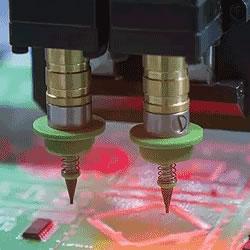Robot Would Assemble Modular Telescope — In Space
A new concept in space telescope design uses a modular structure and an assembly robot to build an extremely large telescope in space, performing tasks in which astronaut fatigue would be a problem. The design is detailed in a paper published this week by SPIE, the international society for optics and photonics, in the Journal of Astronomical Telescopes, Instruments, and Systems by authors from Caltech and the Jet Propulsion Lab.
Enhancing astronomers ability to peer ever more deeply into the cosmos may hinge on developing larger space-based telescopes. A new concept in space telescope design makes use of a modular structure and an assembly robot to build an extremely large telescope in space, performing tasks in which astronaut fatigue would be a problem.
Ground-based telescopes are limited by atmospheric effects and by their fixed location on the Earth.
Space-based telescopes do not have those disadvantages but have other limits, such as overall launch vehicle volume and mass capacity.
Design of a modular space telescope that overcomes restrictions on volume and mass could allow telescope components to be launched incrementally, enabling the design and deployment of extremely large space telescopes.
The design detailed by Lee and his colleagues in "Architecture for in-space robotic assembly of a modular space telescope," focuses primarily on a robotic system to perform tasks in which astronaut fatigue would be a problem.
"Our goal is to address the principal technical challenges associated with such an architecture,
so that future concept studies addressing a particular science driver can consider robotically assembled telescopes in their trade space," the authors wrote.
The main features of the authors proposed architecture include a mirror built with a modular structure, a robot to put the telescope together and provide ongoing servicing, and advanced metrology technologies to support the assembly and operation of the telescope.
An optional feature is the potential ability to fly the unassembled components of the telescope in formation. The system architecture is scalable to a variety of telescope sizes and would not be not limited to particular optical designs.
"The capability to assemble a modular space telescope has other potential applications," said Harley Thronson, senior scientist for Advanced Astrophysics Concepts at NASAs Goddard Space Flight Center. "For example, astronomers using major ground-based telescopes are accustomed to many decades of operation, and the Hubble Space Telescope has demonstrated that this is possible in space if astronauts are available. A robotic system of assembly, upgrade, repair, and resupply offers the possibility of very long useful lifetimes of space telescopes of all kinds."
Thronson is a guest editor for the special section on A Future Large-Aperture Ultraviolet/Optical/Infrared Space Observatory in which the new research appears.
Co-authors with Lee are Sergio Pellegrino, Kristina Hogstrom, and Joel Burdick of the California Institute of Technology; and Paul Backes, Christine Fuller, Brett Kennedy, Junggon Kim, Rudranarayan Mukherjee, Carl Seubert, and Yen-Hung Wu of the Jet Propulsion Lab.
Mark Clampin, James Webb Space Telescope Observatory Project Scientist at NASA Goddard Space Flight Center, is editor-in-chief of the Journal of Astronomical Telescopes, Instruments, and Systems. The journal is published in print and digitally in the SPIE Digital Library, which contains more than 430,000 articles from SPIE journals, proceedings, and books, with approximately 18,000 new research papers added each year.
About SPIE
SPIE is the international society for optics and photonics, an educational not-for-profit organization founded in 1955 to advance light-based science, engineering, and technology. The Society serves nearly 264,000 constituents from approximately 166 countries, offering conferences and their published proceedings, continuing education, books, journals, and the SPIE Digital Library. In 2015, SPIE provided more than $5.2 million in support of education and outreach programs.http://www.spie.org
Featured Product

